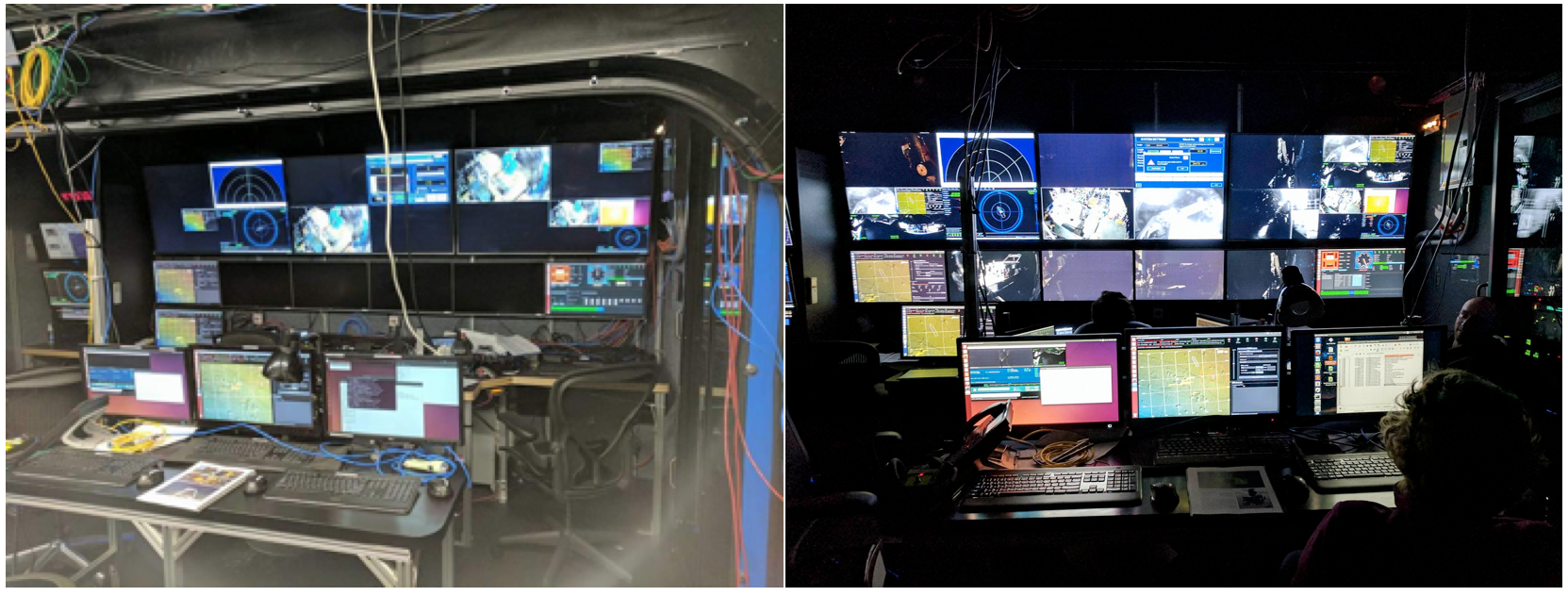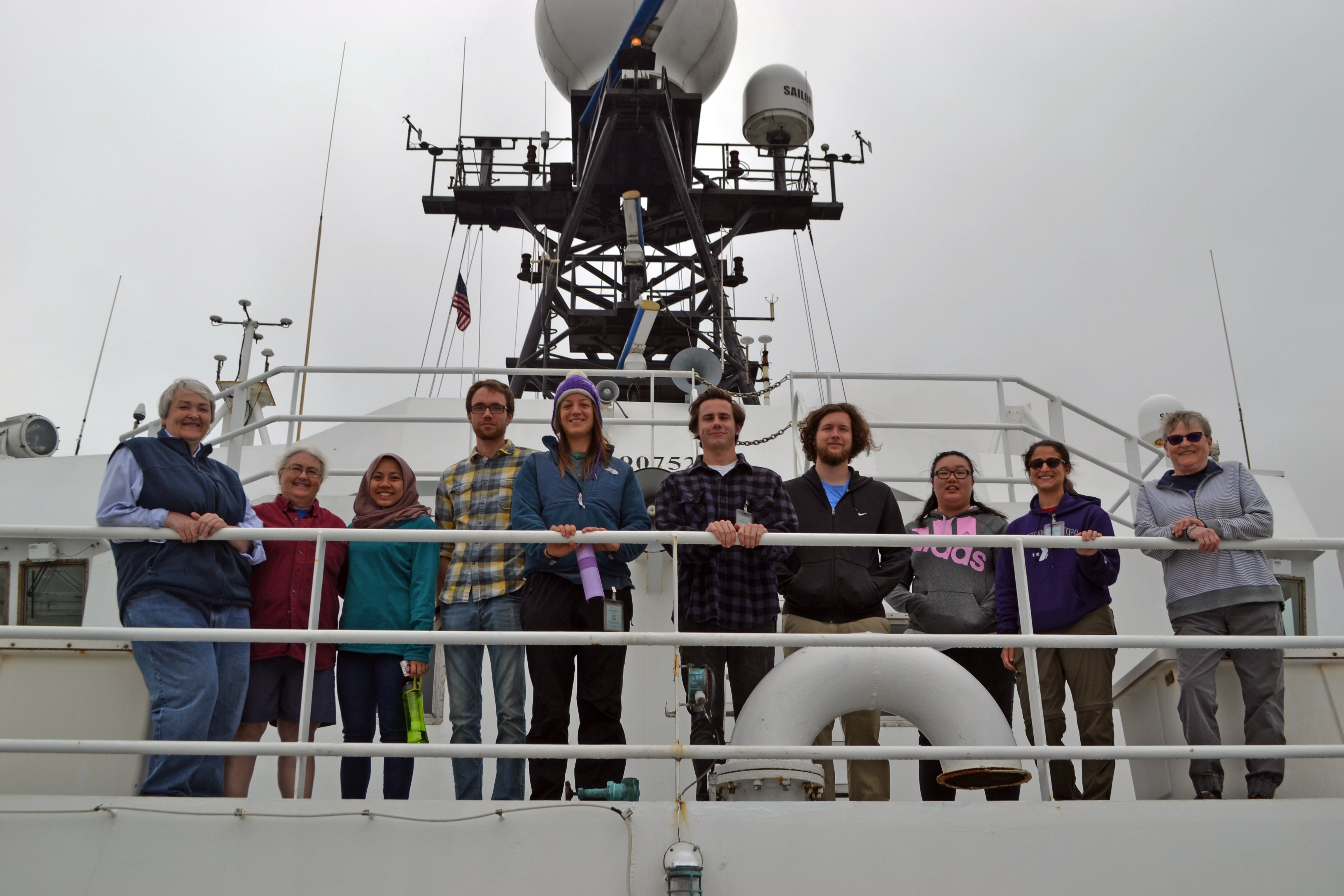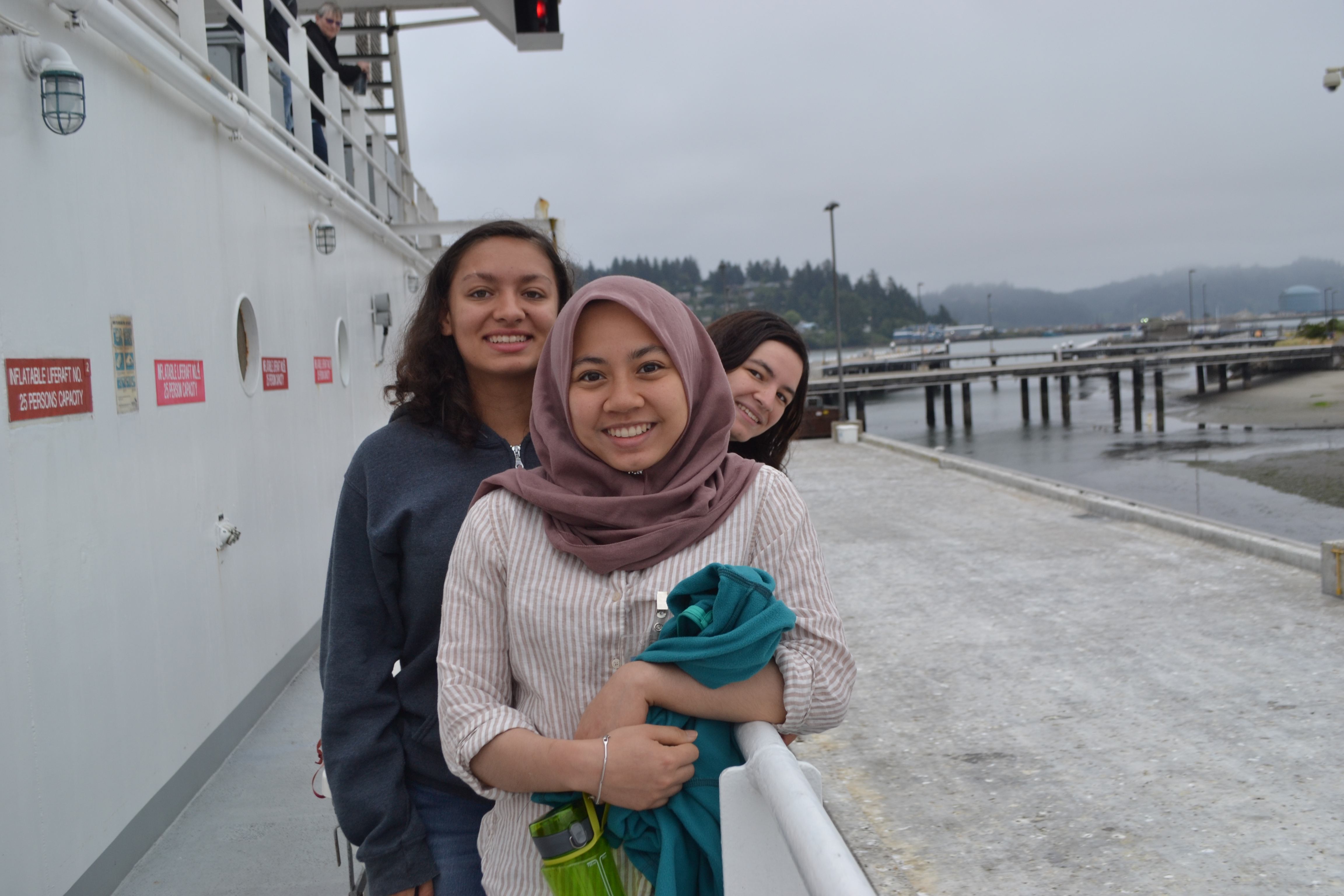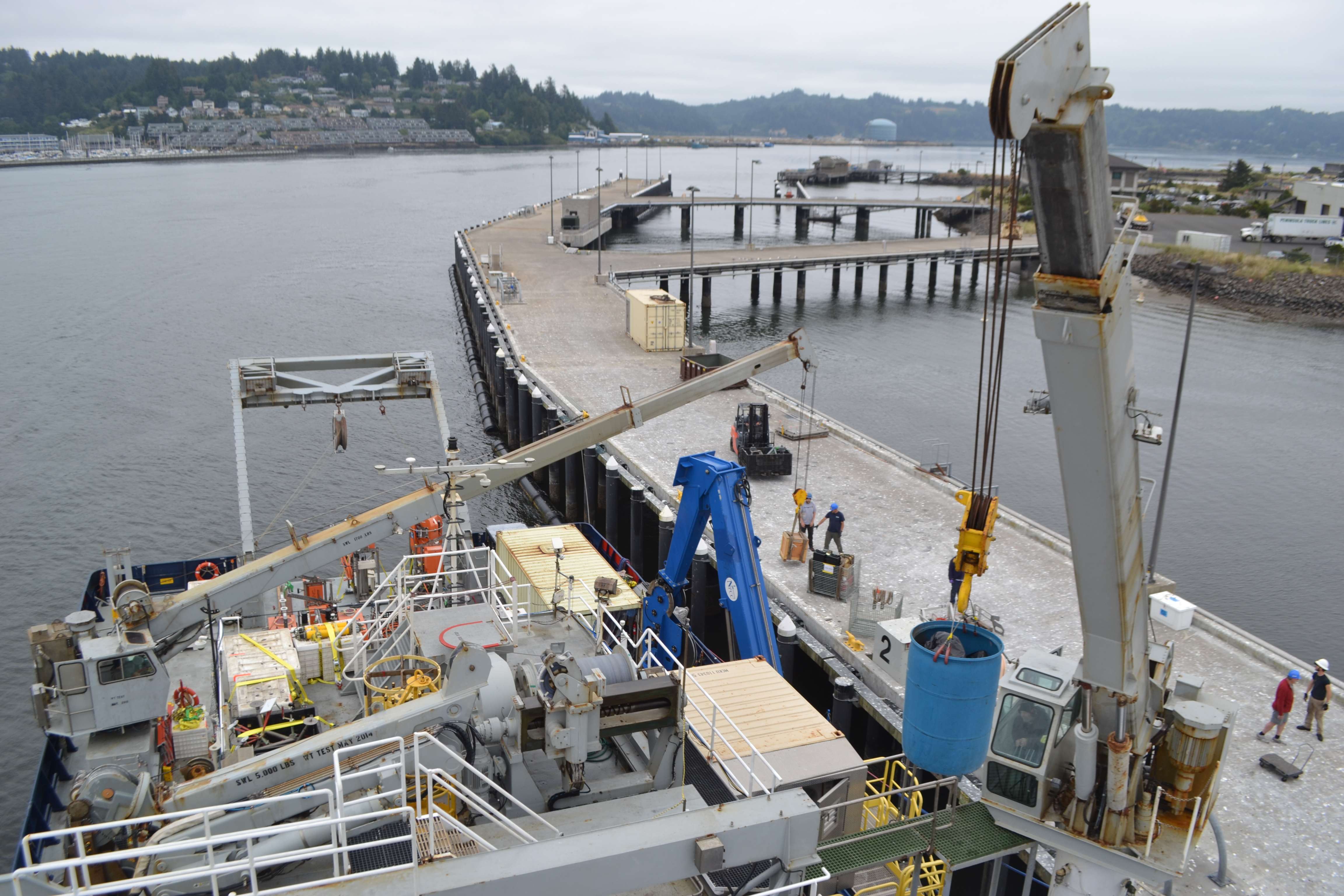Image Archive





























Theresa Whorley (UW School of Oceanography Graduate Student) and Channel Cadot (UW undergraduate) carry an Osmo fluid sampler out to the deck for installation by the ROV Jason during the UW-OOI-NSF Cabled Array expedition. Credit: M. Elend, University of Washington, V17.

University of Washington, Applied Physics Laboratory engineers Skip Denny and James Tilley acoustically retrieve oxygen and temperature data from a seafloor instrument built by Clare Reimers at Oregon State University. Credit: M. Elend, University of Washington, V17.

Overcast skies and calm seas viewed off the bow of the R/V Roger Revelle. Credit: Z. Cooper, University of Washington.

The intake for an Osmo fluid sampler is installed during VISIONS'17. Very small diameter tubing is filled with fresh water; seep fluids are drawn into the tubing osmotically. The fluids will later be analyzed onshore to examine the evolving chemistry of methane seeps. Credit:UW/OOI-NSF/WHOI; V17.

A Mosquito, developed by UW Marine Geologist, Evan Solomon, is deployed at a methane seep at Southern Hydrate Ridge. The instrument pulls in fluids in the sediments with a tracer. The instruments are recovered annually and the fluid chemistry analyzed, providing calculations of the flow of fluids both into, and out of the seafloor. Credit: UW/OOI-NSF/WHOI; V17.

Rockfish, pink soft corals, blue-purple hagfish, clams and starfish thrive around seep environments that host white bacterial mats. Credit: UW/OOI-NSF/WHOI; V17.

A beautiful view of the NE Pacific from the bridge of the R/V Roger Revelle. Credit: S. Seroy, University of Washington, V17.

Sasha Seroy looks stunning in her survivial suit, fondly called a gumby suit. Credit: M. Elend, University of Washington, V17.

Cheryl practises putting on a survival suit as part of safety training on the R/V Roger Revelle. Credit: H. Zulaikha, University of Washington, V17.

Cheryl Greengrove successfully puts on a survival suit as part of the safety training on the R/V Revelle. Credit: H. Zulaikha, University of Washington, V17.

Chanelle tries on a survivial (gumby) suit on the R/V Revelle. Credit: M. Elend, University of Washington, V17.

A view inside the Jason control room before and during an ROV dive. Credit: K. Eyer, Kingston Middle School, V17.

The image is enrapturing. Microorganisms swirl and pulse with activity. A salp (bottom right) drifts idly through a sea green with phytoplankton. Comb jellies slide gracefully by, rainbow lines radiating from their cilia. We joke it is the perfect setting for a screensaver. Credit: K. Eyer, Kingston Middle School, V17.

Julie Nelson, from Grays Harbor College, samples fluids collected from deep NE Pacific waters off Oregon from Niskin bottles on a CTD-rosette. Credit: M. Elend, University of Washington, V17.

drone_20170810-poster

A "snow storm" of material in the shallow waters (80 m) off of Newport, Oregon prevented the ROV Jason from recovering and redeploying the Bethic Experiment Platform during the first two dives of the VISIONS'17 program. These waters are some of the most biologically productive in the worlkds' oceans. Credit: UW/OOI-NSF/WHOI; V17.

A view of the R/V Roger Revelle, operated by Scripps Institution of Oceanography, as viewed from a drone flown by Applied Physics Laboratory engineer, Chuck McGuire. Credit: C. McGuire, University of Washington.

A view of the inside of the Jason control van at the beginning of Leg 2. Jason is working on the a Benthic Experiment Package off of Newport Oregon. Credit: Z. Cooper, University of Washington, V17.

View from the vessel while leaving the dock under misty/foggy conditions. Credit: Michelle Lee, University of Washington, V17.

Faculty and students enjoy their first transit out of Newport, Oregon on the R/V Roger Revelle at the start of the UW-OOI-NSF Cabled Array VISIONS'17 expedition. From left to right: Deb Kelley; Cheryl Greengrove; Hanis Zulmuthi; Kevin Eyer; Chanelle Cadot; Kevin Lally, Zach Cooper, Michelle Lee, Sasha Seroy, and Julie Nelson. Credit: M. Elend, University of Washington, V17.

screenshot2017-08-09at9.10.28pm

j2-978.snap_

j2977

j976snap

j975-snap

Hanis, Eve, and Monique prepare to disembark from the R/V Revelle at the end of the VISIONS'17 UW-OOI-NSF expedition. Credit: M. Elend, University of Washington, V17.

A curious sea lion watches the R/V Revelle pass by heading out on Leg 2 of the UW-OOI-NSF Regional Cabled Array. Credit: M. Elend, University of Washington, V17.

Two cranes operate to mobilize and demobilize the R/V Revelle between Legs 1 and 2 of the UW-OOI-NSF Regional Cabled Array operations and maintenance cruise. Several tons of equipment will be off- and on-loaded during the two days in port. Credit: M. Elend, University of Washington, V17.
- Anemone
- Animal
- Arthropod
- ASHES
- Axial
- Axial Base
- Axial Biology
- Axial Caldera
- Bacteria
- Basalt Lava
- BEP
- Biofouling
- biolgoy
- Biology
- Camds
- Camera
- Camhd
- Central Caldera
- Ciliates
- Cnidaria
- Coastal Biology
- Crab
- Deep Profiler Mooring
- Dive Highlights
- Eastern Caldera
- Echinoderms
- Endurance Array
- Engineering Team
- ENLIGHTEN 10
- Exploratorium
- Fish
- Geology
- HD Camera
- HPIES
- Hydrate Ridge
- Hydrates
- Hydrophone
- Hydrothermal Vents
- Illustration
- Inshore 80 Meters
- Instrument
- International District
- J-BOX
- Jason
- Jellyfish
- Junction Box
- K12
- Lava
- Mollusk
- Moorings
- Nodes
- Nudibranch
- Octopus
- OOI
- Oregon Offshore
- Oregon Offshore 600 m
- Oregon Shelf
- Oregon Slope Base
- People
- PN1B
- PN1D
- Polychaetes
- PPSDN
- Primary Node
- RASFL
- ROCLS
- ROPOS
- ROPOS Dives
- ROV Team
- RV Revelle
- RV Sikuliaq
- RV Thompson
- Salp
- Sample
- SC13
- Science Team
- Sea Cucumber
- Sea Star
- Sea Urchin
- Seafloor
- Seismometer
- Sensors
- Shallow Profiler Mooring
- Shark
- Shipboard
- Shore Station
- Slope Base
- Smoker
- Soft Coral
- Southern Hydrate Ridge
- Sponge
- Squid
- Students
- Students & Guest Participants
- Tmpsf
- Tubeworms
- VISIONS 11 Leg 1
- VISIONS 11 Leg 2
- VISIONS 11 Viewers
- VISIONS 13
- VISIONS 14
- VISIONS 15
- VISIONS 16
- VISIONS 17
- VISIONS 18
- VISIONS 20
- VISIONS 22
- VISIONS 23
- Visualization
